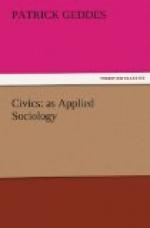Our modern town is thus in a very real sense, one not hopeless, but as hopeful as may be, a veritable purgatory; that is a struggle of lower and higher idealisms, amid the respective expressions and outcomes of these. Indeed, in our own present [Page: 97] cities, as they have come to be, is not each of us ever finding his own Inferno, or it may be his Paradise? Does he not see the dark fate of some, the striving and rising hope of others, the redemption also?
The supreme poetic utterance of the mediaeval world is thus in great measure, as each thoughtful reader sees, an expression of impassioned citizenship and this at one of the golden moments of the long history of city life. This expression—this exiled citizen’s autobiographic thought-stream—is resumed at every level, from youthful home and local colour, from boyish love and hopes, from active citizenship and party struggle, to the transfiguration of all these. Hence these mystic visions, and these world ambitions, temporal and spiritual; hence this rise from cloistered faith and philosophy into many-sided culture; hence the transformation of all these through intensest symbol-visions into enduring song.
Am I thus suggesting the Divina Comedia as a guide-book to cities? Without doubt, though not necessarily for beginners. Yet who can see Florence without this, though we may pack below it Baedeker and Murray? Or who, that can really read, can open a volume of Mr. Booth’s severely statistical Survey of London, with all its studious reserve, its scientific repression, without seeing between its lines the Dantean circles; happy if he can sometimes read them upward as well as down?
O—A CIVIC SYMBOL AND ITS MEANING
But such books of the city, whether of the new and observant type, from Baedeker to Booth, or of the old and interpretative Dantean one, are too vast and varied to keep open before us. Even the preceding open page of diagram is complex enough with its twofold, indeed four-fold city; and we are called back to our daily work in the first of these divisions, that of the everyday town. Since its subjective aspects of school and cloister may fade from memory, its higher aspect also, that of city proper, how can we retain this fourfold [Page: 98] analysis, and how test if it be true? Take then one final illustration; this time no mere logical skeleton, however simple or graphic, but an image more easily retained, because a concrete and artistic one, and moreover in terms of that form of life-labour and thought-notation—that of current coin—which, in our day especially, dominates this vastest of cities; and hence inherits for the region of its home and centre—“the Bank” which has so thoroughly taken precedence of the town-house and cathedral, of the fortress and palace—the honoured name of “City.” The coinages of each time and place combine concrete and social use with statements of historic facts; and they add to both of these a wealth of emblematic suggestions: but that is to say, they express not only their town, and something of its school, but much of its thought also, its cloister in my present terminology.




